A carrier that develops in a period of more decades like that of Queen, necessarily compares with a big variety of other artistic currents and expressions. First, of a visual nature not only for the importance of this kind of communication in the XX century, but also for the will manifested by Mercury and companions to invest in new communicative forms, first of all the video clip, until then unexplored together with music: it is in 1975, thanks to the invention of the first promotional video (specifically that of Bohemian Rhapsody) that the interaction occurs – as much as it was obvious later so it was ingenious in the beginning – between popular music and television diffusion, the latter released by the physical presence of the performer.
The video on the one hand guarantees a new unpublished mediatic presence (see how the same process occurred decades before thanks to the use of audio recording supports), on the other hand in some measure it takes its distance from the performer and nearly can do without him – relegating him only to his image – for practical and economical problems: it is therefore a bivalent communicative form which comes out in the middle of the ‘70’s and that no-one knows how to use yet, even if the mass homologation has been occurring since 1964 with the programme “Top of the Pops” (that doesn’t use video clips like we know them today, but of performances recorded in different studios and re-proposed worldwide using the same set design so that it gives the illusion that it all took place in one studio), it will later become a format constantly used by the broadcaster MTV dedicated only to non stop promotional musical video clips.
The concept of semantic nature is expressed in an exemplary way by Dick Hedbige (Note 1):
That which could be considered as the definitive characteristic of the video clip (is) the substitution of the coherent fiction with the referential density. Meanwhile the index-link signs – which carry on the story – succumb to the referential signs – those that evoke the atmosphere, define the mise en scène giving fundamental elements to “characters” and “style” (dressing up, pose, lights, special effects etc…) – the video clip becomes a way to “tell a story” rather than to “tell of an event”.
It is then possible to analyse and to reconstruct true and proper iconographical journeys of Queen’s carrier to understand better the choices the group took regarding costumes and set designs used for their videos, a huge job is concealed behind their album covers and in a yet deeper way in their song structure. In short an external artistic current (and apparently without conjunction points) matures contemporaneously in the group on more levels, and finds new expressions in the most unimaginable ways, but that always leave traces from which to work on to track down the original source.
The fundamental point of the subject is to understand how this interpenetration between visual art and music never occurred at such a deep level and rich of consequences beforehand, but is an exclusive prerogative of the XX century. What has then allowed this new relationship among worlds apparently without any reciprocal communicability? The answer has to be found in the reproducibility of art and in the unknown or little considered aesthetic consequences before the nineteen hundreds: works of art reproduced thanks to the invention of photographical means (higher in quality than prints and engraving of the previous centuries) take pleasure in a new and unpublished diffusion, and of a life of its own that doesn’t fear the passing of time.
Visual knowledge in general proliferates and knocks down barriers, because potentially everyone has reproduced photographically an “original”. And so even the relationship that is created between music and images must be interpreted in this direction: a song that is not only inspired but aims to give a musical representation of an object until then exclusively visual (belonging to another aesthetic sphere) like a painting, is nothing but yet another reproduction on another scale of the original itself, in the sense that the variations should be interpreted as a new “original” to all effects and with all the artistic and aesthetic values connected to this vision.
The iconographical and musical journey interlace as they have never done before, and not only because both expressive means can become a new original but also because one can inspire the other (also music can become visual art, like some programmes of graphic equalizing can do). It is then worth the while to stop on certain aspects of Queen carrier and analyze the richest in significance and best worked out examples, those that interacted with different artistic currents – photography, video, images and with dancing as figurative art – made to create a new form of expression that keeps count of the original but becoming a new model from which to find inspiration.
The first video-iconographical journey analyzed is not only the more complex but also the richest in subsequent ramifications, it is a fascinating example that shows how the same image (photo or video) can be modified, transferred and past on in different contexts, on the one side keeping its peculiarity on the other creating new expressive contexts.
The idea that originated the cover of the album “QUEEN II” is a photo taken from the film Shanghai Express of 1932 directed by Josef von Sternberg (the film won the Oscar for the photography), in which the leading actress Marlene Dietrich assumes a statuary position with arms crossed and looking straight into the camera: a strong but simple image exalted by black and white. Therefore an image born in a film context but that is transferred and reproduced straight away in a photograph; and also Queen for their album cover choose the same pose forming a cross and keeping the background black (even if the photo is in colour) in order to exalt even the better the photograph of the four musicians.
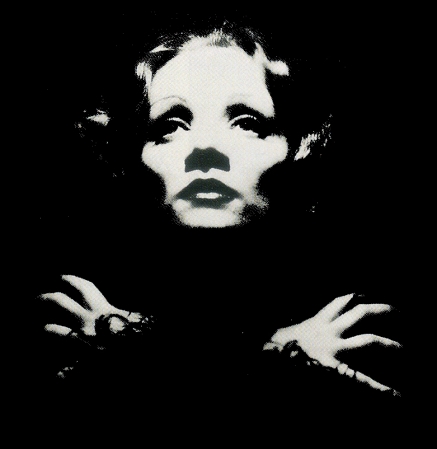
A similar chromatic contrast appears in the opening album cover, but this time the predominant colour is white, and the binomial of colours amplifies and prepares a hand contrast that is though present in the furrows of the vinyl itself, in which the two facades oppose in a clear way.
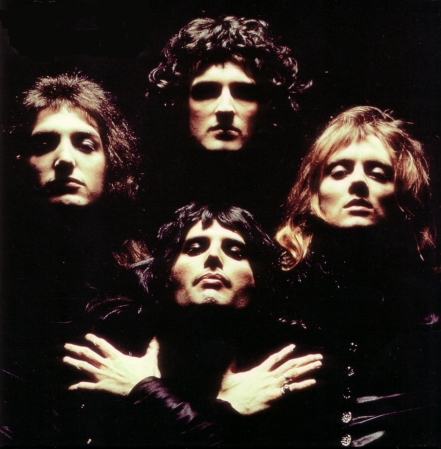

The photographer author of the photo of Queen, Mick Rock, remembers and justifies the choice of the original source in an interview on the magazine Rolling Stone:
It should have been a photo of the whole band, and have as a theme white and black (like the whole album project). A friend […] showed me a photo of Marlene Dietrich from the set of the film Shanghai Express. It was an immediate intuition, strong. It was the perfect image for Queen; fascinating, mysterious, classic. […] I believe to have been the only one that understood the dualism that was in their music: the light and the shadow, white and black. There was always tension between these two poles. The result was strong and involving, like in dramatic opera.
This image born from a film and passed on to photography in two different contexts has yet not finished to exert its influence: in fact when the following year Queen decide to record their first promotional video clip they will make once again use of that pose to open the first frames of their video (and note how the video of Bohemian Rhapsody doesn’t belong to the album “QUEEN II” or to the following album, but to the album “A NIGHT AT THE OPERA”).
Moreover Queen themselves ten years later making their own an aesthetical auto reference cite themselves and will assume in another video (One Vision) the same pose but showing the years that have gone by: even if the disposition of the four is identical, the costumes are different and the look of the musicians has changed totally.
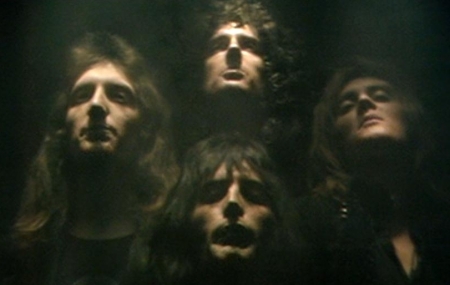

Nevertheless the story doesn’t finish here, neither would it be possible because each new re-interpretation of the subject gives necessarily place to a semantics osmosis and goes to create new original sources: now it is ideally possible to close the circle, because if the iconography here presented was born from a photo and on the set transformed first into a new photo and then into two video clip, here at the same time the two video were re- transformed (or rather the iconography by them represented) in photos of scenery referred to themselves, how the following image shows:

As from this image we can analyze how Queen’s graphical logo changed during the years: in fact present on the t-shirt of John Deacon in a stylized way shown in the photo above, such logo initially appeared on the rear side of the album “QUEEN”.
But it is only with “A NIGHT AT THE OPERA” and the following “A DAY AT THE RACES” that Queen symbol, where the zodiac signs of the four members are united thanks to Mercury around the “Q” that is the initial of the quartet, becomes leading character, and throughout the years will appear in their albums three times in their greatest hits’ albums “GREATEST HITS II”, “CLASSIC QUEEN” and “QUEEN ROCKS”; a similar frequent use of the logo is also found in many of their single albums. In detail, the two lions symbolize the zodiac sign of Roger Taylor and of John Deacon, Cancer that of Brian May, meanwhile the two fairies symbolize the Virgo of Freddie Mercury; the phoenix which reigns on the group of figures is the symbol of strength and power. Also in this case the basic idea is stable but is modified each time, it is adapted to the albums: in this case it is not an adjournment of the logo with the passing of the years but of an iconographical re-interpretation, of which the story can be easily made up in a visual level.

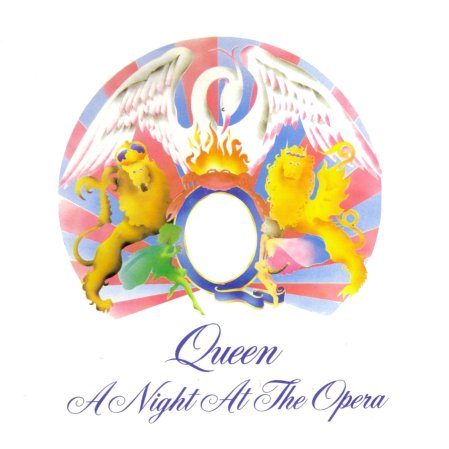

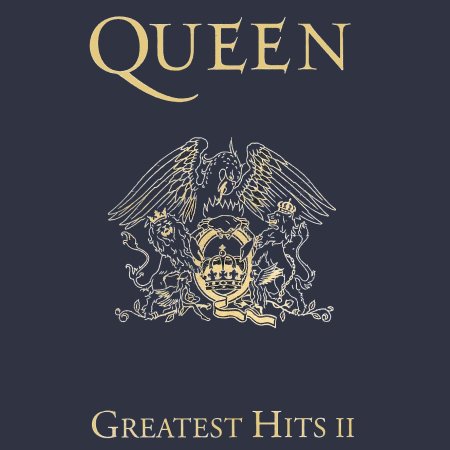
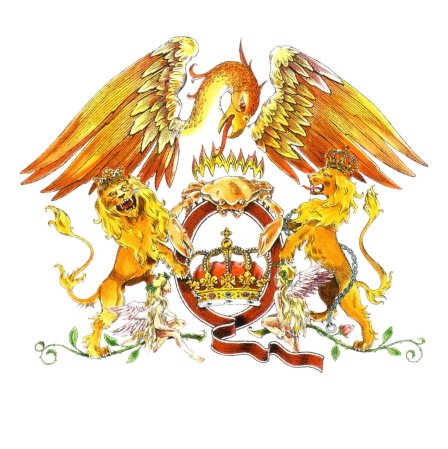
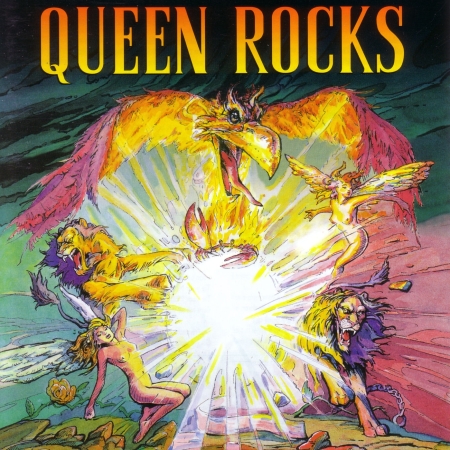
The groups logo exists not only on the albums’ covers but also on the drums of Roger Taylor during the concerts that took place in the seventies: also in this case there are many variations, sign not only of the groups inventive skill, but mostly a communicative research in a direct confrontation with the public, as an ulterior exaltation of the costumes, lights and special effects. Here is an example of the logo in its positive and negative variations, that were used in a tour without a precise chronological scanning (notice as a matter of fact Freddie Mercury’s dress). Logically at the same time with the logo the type of character used for the different albums changes, and in a particular way the word “Queen” which identifies the group each time in a an autonomous way, with its colours, images and forms.


Browsing through the most significant covers of their albums, one notices that in a few of them there is a precise choice to make sure that a particular image emerges so that it resumes in itself the overall weight of the album and its contents. Besides the above examples – and concentrated on the presence of Queen’s logo – many other albums exist, some that must be observed with attention, while others that are excluded from this research have characteristics less innovative and are mostly photographical covers of no particular artistic importance. Proceeding in chronological order, the album “NEWS OF THE WORLD” published in 1977 presents itself with a graphical science fiction cover (with a view of the argument properly of the ‘50’s); here is the genesis of the image related in the official biography:
During the recent trip to the United States, Brian [May], keen on science fiction, had browsed though an American magazine Astounding Science [in particular the number of October of 1953]. On the cover there was an image of a robot that scattered panic and destruction among the human population, a work of the artist Frank Kelly Freas. Roger [Taylor] thought that the robot with some variations, would have been perfect for the cover of an album. It took a while but at last the elusive mister Freas was found. The artist appreciated the idea and well accepted the variations proposed to him: the persons that the robot was to hold in his huge hand were to look like Freddie [Mercury], Brian [May], Roger [Taylor] and John [Deacon]. Freas created also the inside cover of the album (Note 2).
The comparison between the two images show minimal differences regarding though mostly the human beings represented (meanwhile the robot doesn’t undergo any changes), in common stays the intense colour green in the background; and it’s not a chance that in the French version of the vinyl this colour was chosen instead of habitual black.
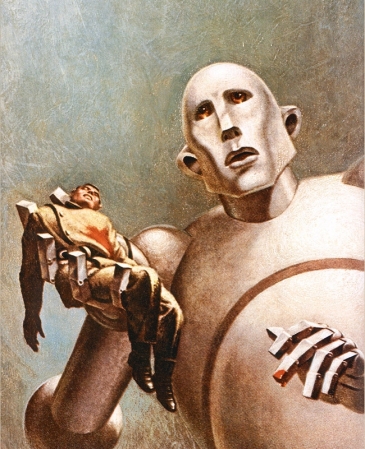

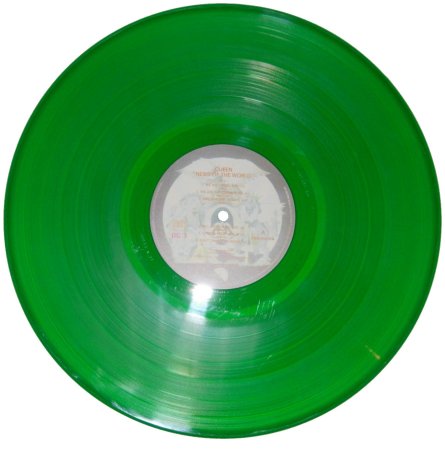
And there is more: in fact both the inside of the cover and the front cover seen in its wholeness (so with the record open) carry out the same image and suggest similarly to a strip cartoon, also a logic progression of the events; therefore also at an iconographical level in the covers and albums it is possible to trace a kind of reading that becomes unmistakeably dramatic and is thought in a precise time scanning.
In fact the robot that is represented together with the four members of the group are close to falling in a chasm similar to the crater of a volcano, on the inside cover he has already opened wide the crater and is reaping many victims amongst the common people, that flee with terror and confusion.


The presence of the robot doesn’t finish its correlation with the album it also doesn’t end with the cover image but it is extended also to the iconography of the singles’ covers taken from “NEWS OF THE WORLD”, a sign that shows the will to give uniformity to the group of songs also on the designs point of view. Therefore many other single albums can be cited, whose graphics was inspired by the image of the robot and of the terrorized fleeing crowd.
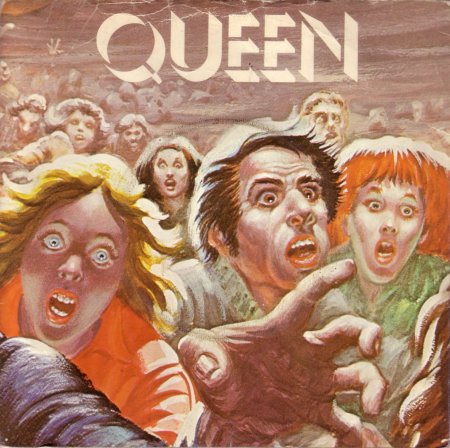

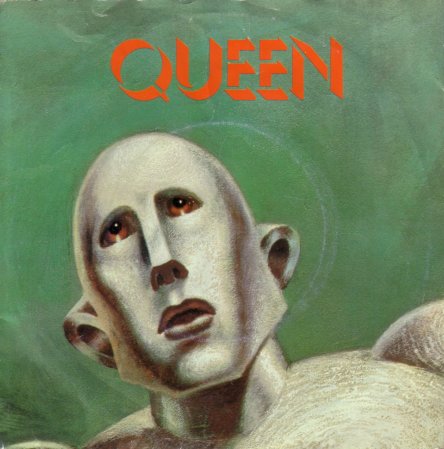
The images collected vary from advertisements that appeared in several magazines (European, American and Japanese) of that period, to promotional posters of concerts, and merchandising and promotional articles (mirrors, t-shirts and pins), to the cover of the tour book of that year, without excluding the shape of the robot on the group’s drums (keeping a logical connection already presented), up to its concrete plastic art realization in the occasion of promotional meetings or of scale models for collectors.The decision to pursue a definite graphical aim is extended also to other aspects and involves other fields apparently far from the albums iconography itself, but always connected to it. Always staying in the field of “NEWS OF THE WORLD” one can notice that the image of the robot appears in many different objects and situations that give though – seen in their togetherness – uniformity to the period considered and allow therefore the construction of an iconographical journey that develops in various directions starting from the original packaging of the album.

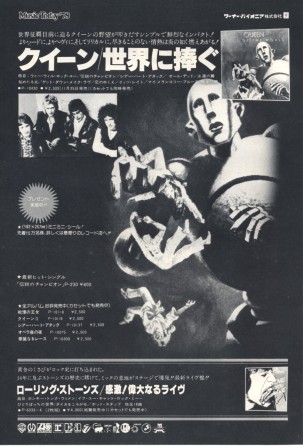











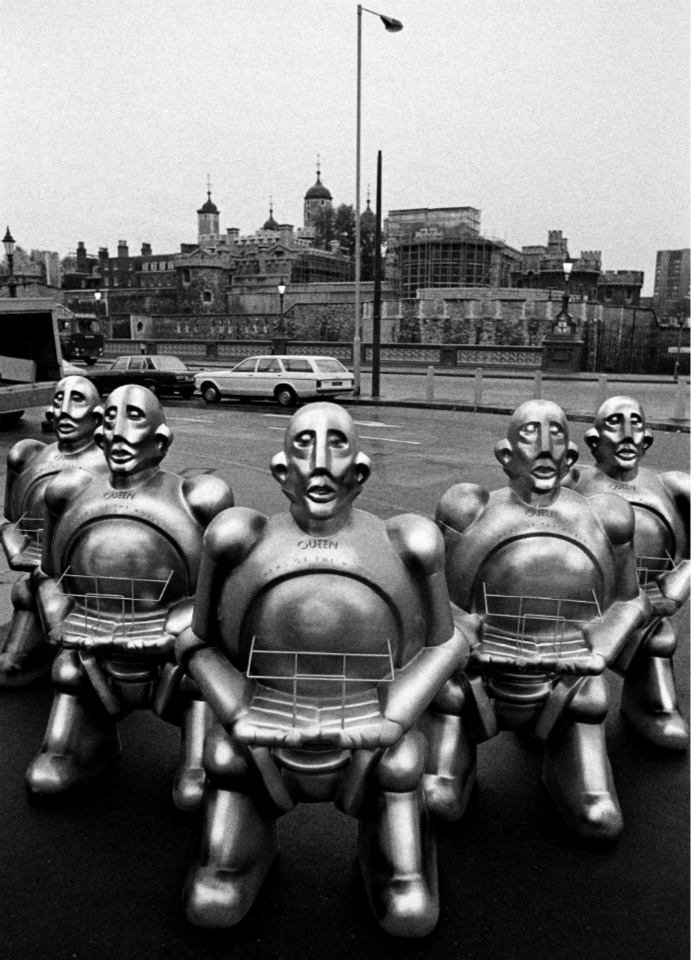

In 2017, to celebrate the 40th years anniversary of the LP “NEWS OF THE WORLD”, a limited 200 pcs edition in vinyl of the album has been published together with Marvel: the new layout takes inspiration from the original but the X-Men characters are new and derived directly from the comic book world; and a comic book has been published with the new image as well.
So, a LP cover that was originally inspired from a comic book, at the end itself inspired a comic book and a new record with a unique artwork closing ideally the circle of influences from different artistic worlds.
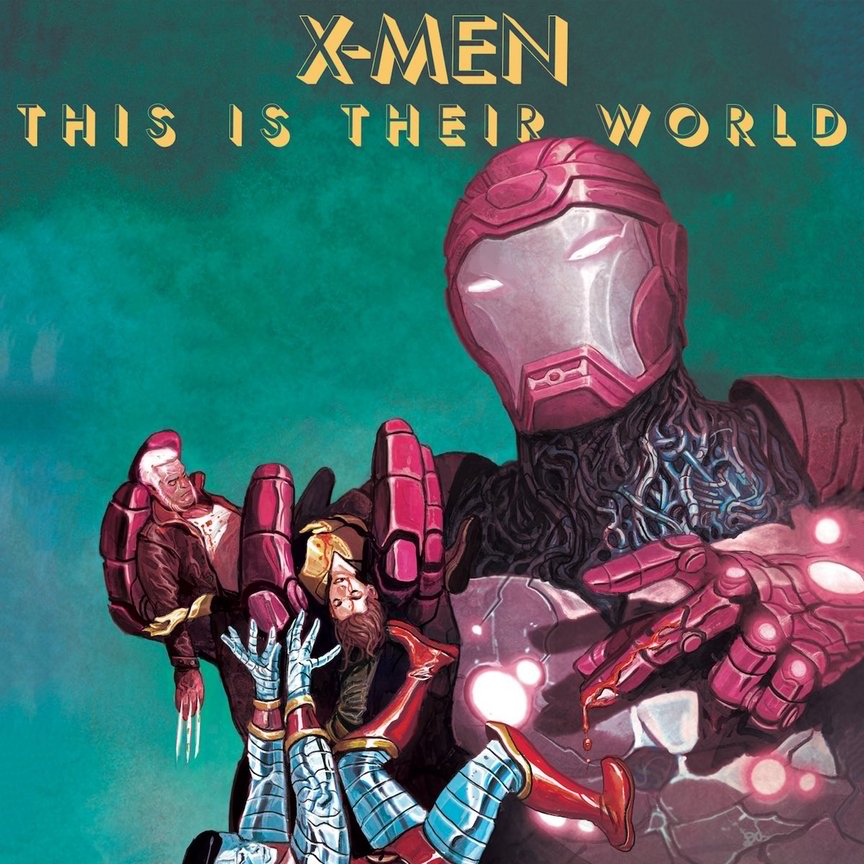
The cover of “JAZZ” reproduces a whirl of concentric circles taken from a graffiti seen by Freddie Mercury on the Wall in Berlin, but at the same time with its circularity symbolizes the movement of the wheel of a bicycle, and recalls the song Bicycle Race contained in the album: to reinforce this theory there is the presence of a series of images that represent some women on a bicycle, a hint to the title of the song (but also Fat Bottomed Girls, that together create a inseparable binomial shown also with a single album with two side A).Other Queen covers show an expressive will and a graphical sensibility, like the covers of “JAZZ”, “HOT SPACE”, “A KIND OF MAGIC” and “THE MIRACLE”, all out to give a visual immediateness that can represent the contents of the albums they belong to.
Furthermore the idea to have 65 naked girls running at the Wimbledon Stadium, the winner would have posed for the cover of the album cited.
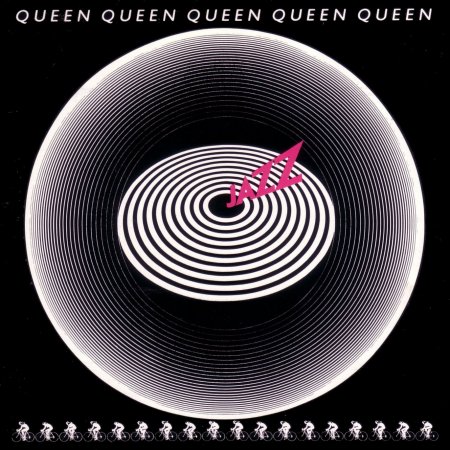
The inspiring graphics of “HOT SPACE” if on the one hand traces some works of Andy Warhol for the presence of the four faces of the musicians on fully coloured backgrounds, on the other hand it wants to make emblematically visual the musical turning point which the group took with the publishing of this new work, oriented not with the scratching rock of their origin but towards a nearly anticipating rhythmical music that later become known as Disco Music. And then also the bright colours in the background seem nearly disco lights that pulse like in many of their songs contained in their album.

“A KIND OF MAGIC” presents the four members of the group drawn as cartoons, with the same graphics used in the promotional video clip of the homonymous single; in this case the lightness of the cover if on the one side is justified by the title of the song, on the other it was to totally loosen itself from the concept of a normal album, being the album conceived mainly as the theme song for the film Highlander.
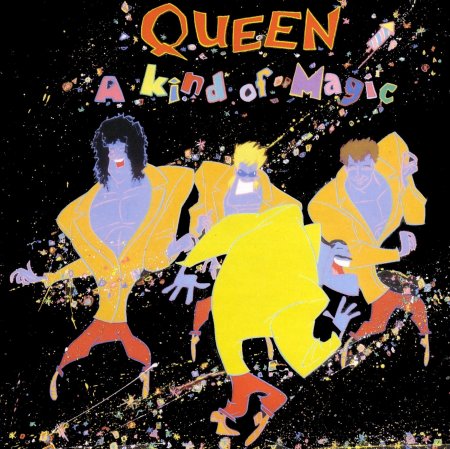
The theme of the eye and the fusion of the faces of the four musicians – together with the light blue colour in the background – is the predominant graphical theme of the album “THE MIRACLE” and of the singles taken from it, for example Breakthru or The Invisible man.

Also here though the original work done on the cover (but notice the incredible resemblance with the film poster Dead Ringers of David Cronenberg that came out the year before the publishing of the album) is not only used for the album, because it is re-proposed on the back cover as true and proper pattern and also because it is present in the singles’ covers, that allow to see a new found unity after the group’s three year absence from musical scenes: it’s not a chance that “THE MIRACLE” is the first album of Queen’s carrier on which the signature of all four members appears on each single song, of course to cement a common expressive will, but also a deeper and felt bond.


The iconographic source for the multi-face figure joined together is quite unusal but it can be tracked at least to the IX century when this figure originally recalled the Holy Trinity (even if later it was refused by artists because it could recalled the three head demon too).

Queen never appear in these drawings (an emblematic choice for that, that will be Freddie Mercury’s last published work while alive), and the albums and the singles are characterized by creatures and persons that are rather curious in the act of playing, and that have an independent space thanks to the homogeneity of the white backgrounds; and white is the predominant colour of the album.But the most complex case is that represented in the album “INNUENDO” in 1991. For this album Queen appealed to the illustrations of the French caricaturist Grandville, pseudonym of Jean Ignace Isidore Gèrard (1803-1847) author of illustrations that are in the spirit of absurd and unnatural caricatures, but that represent at the same time an ingenuity that reveals to to be the source of inventiveness: and so the visionary and oneiric appearance assumes its own intrinsic rationality.
The illustrations are reproduced without any intervention in order to preserve the originality and pureness; it’s always Grandville the author chosen by Queen to illustrate the scores of “INNUENDO”, showing in this way a coherent and mature artistic choice, similarly to that made years before with “NEWS OF THE WORLD”.






The only image of the group is found in the internal illustrations of the album: besides a photo which has the only particularity of being lengthened vertically and is of intense shades of blue, the four musicians appear with their own faces in another image in which they are adorned and dressed in a caricature way similar to that of Grandville. The cover of “INNUENDO” has a disarming lightness and it opens as if to suggest an extreme fragility and relativity of earthly things with that clown that juggles with different worlds, amongst which the earth in a marsupium, while an outside observer looks on frightened moves backwards because nearly hit by a banana: these are the details that make Grandville’s works unique and that suggest an ironic mood in contained in them.


But with a careful examination there is more, in fact each component of the group is represented together with animals or objects that represent their passions: so for example Brian May on his clothes he has not only a small guitar (his instrument) but also a telescope (he has a degree in astronomy), meanwhile Freddie Mercury, a cat lover, is surrounded by small felines; John Deacon is dressed like a clown (a tortoise and a hare keep him company) and Roger Taylor is dressed like a chiromancer with a bandana.
It is starting with Bohemian Rhapsody that the world of video clips assume those characteristics that stay unchanged, and that see in the years also efficient film directors participate in the creation of that, that becomes a film of only 3-4 minutes; but at this point in the video all the best professional and technical figures have combined in the creation of a new and immediate language, that with the power of images must now how to exalt the song, so much that some times one can notice a crossing of roles and the music risks to be supplanted by the image.
The video clip for Save Me shot in 1979 and directed by Keith McMillan is absolutely of the first video clip that blended parts shot live with animated parts. Born from a concept of Brian May, the video alternates parts shot live with the four musicians in studio (they mime a live performance) to others that tell the story of a girl: the interaction between the two film worlds – worlds that live in their own zone dictated by the structure of the song – it is though guaranteed by a skilful use of cross fading that allows the girl to belong to both worlds cited; moreover the presence of a white dove with a sparkling light (which fades into Mercury’s figure twice) is another element that comes back to unite the two realities giving them formal coherence.
The film Metropolis directed by Fritz Lang in 1926 (and known by Mercury because he cured the new soundtrack as a soloist) is at the bases of the video of the song Radio Ga Ga taken from the film “THE WORKS”. The video directed by David Mallet has different interesting elements; besides showing sequences of the original film, he inserts in the scenery Queen on board of a flying machine. The fact that he uses colour as much as black and white is rather curious, meanwhile also the format of the video is often modified, spacing from 4:3 to 16:9 with the effect that the image is lengthened and widened at pleasure. Famous is the image where Queen clap hands to the beat imitated by the huge crowd of appearing actors (an action imitated during their public concerts), as in the one where Mercury does a few sequences of the film of Lang or he overlays on them with special effects. One mustn’t forget the modern manner of citing themselves, so they appear in a sequence short fragments of previous videos and live performances.
Always in 1984, and with the director Tim Pope, the promotional video for It’s A Hard Life was born: an orgiastic and carnival masterpiece of colours and costumes in full baroque style, far from any half measures. Everything appears to be pompous, and every detail taken to extremes; and also the table is set in a unnatural way is an ulterior iconographic element that must be interpreted in this context. We find the horror vacui properly baroque, therefore every detail is seen to in an unbelievable way (see the wigs of the table companions) and fills every possible space of the scenery. (Note 3)
With Mercury being the absolute leading character – thanks to the precise light combination – and the other group members in second place (only May has a small appearance during his guitar solo, but in this case it is the instrument that becomes the leader because of it’s strange skull form), the video seems to nearly want to give a visual image of the short introduction of the song that starts off by musically citing – the aria of Ruggero Leoncavallo “Vesti la giubba”.
A Kind Of Magic (1986) has as a video clip a work filmed by Russel Mulcahy, the same director of Highlander, of which the song is the film’s soundtrack, and from which he took inspiration: from a narrative point of view it is the story of a character, interpreted by Mercury, that in an abandoned theatre with the help of magic he is able to transform the homeless (May, Taylor and Deacon) that use the theatre as their home into musicians, accompanied by choirs of other magical figures, to then abandon everything at the end of the video, in order to put everything like it was initially.
Plasticine dancing models, that took 4 weeks of work are used as a narrative and musical interval, and the drawings of Grandville already used for the album are animated and alternated with the caricatures of Queen themselves. But the group members when they are projected on the imaginary screen, appear each one with a different graphical style that is of other eras or authors: Freddie Mercury is represented with features similar to that of Leonardo da Vinci, Brian May with features of a Victorian period etching, John Deacon assumes features in a Picasso style and Roger Taylor is painted in a Jackson Pollock style.The most complex video of all the videos of Queen is that shot for the single album “INNUENDO” in 1991. More than 6 minutes long and directed by Jerry Hibbert and Rudi Dolezal, the promotional video clip presents a big variety of elements to analyze: first of all the scenery that is that of a cinema but where the audience are marionettes and on whose screen is not only projected Queen playing, but mainly various repertory images and of social military disposition (armies belonging to big dictators appear but also the explosion of a nuclear bomb and its disastrous effects).
The video wants to a be a homage to a certain classical cinema, and in fact also the scene in which the tie is cut is not casual but it’s a citation from the film by the Marx brothers, that had already inspired Queen with the titles of the albums “A NIGHT AT THE OPERA” and “A DAY AT THE RACES”. An only bright coloured note associated to Mercury, nearly a symbol of hope given in a visual way, but destined to disappear in a moment leaving yet an indelible recollection.Emblematic is one of the last videos shot where Mercury still appears, specifically for the single album I’m Going slightly Mad: directed by Rudi Dolezal and Hannes Rossacher in February 1991, this work presents subtle characteristics and of non immediate understanding. Shot in black and white, the video shows the members of the group always made up in a bizarre way, to better resemble the madness cited in a textual level, in fact most images are nothing else but the film transposition of the text of the song. This explains the oneiric and unreal adaptation (with Mercury waking up with cadaverous ways and make up in a field of silk daffodils, citing in this way his love for flowers already expressed in Wordsworth romantic English poem), the presence of penguins and of a beheaded gorilla.
David Mallet also directs the video clip in 1995 Heaven For Everyone, that can be interpreted in two ways: if at a first level it is a declared homage to science fiction films of the beginning of the century of Georges Méliès (and of his masterpieces Le voyage dans la Lune in 1902 and Le Voyage à travers l’impossible in 1904, inspired from the narrations of Verne – See Note 4), from which he draws the images to reconstruct the amazing enterprises of the leading characters, on the other it is a homage to the same Queen that never appear directly close up but only through crossed fading that nearly integrate the musicians in the context of the original video. The opening of the video is dedicated to the main door of Mercury’s London house, on which the fans left their messages of solidarity: it is the only part of the video entirely shot in colour, the original colours of Méliès were added in a second time. That which remains is a sensation of lightness and of parting, other than regret for a time that doesn’t exist anymore, and of lost sensations that maybe can only be found in heaven, like the title of the song seems to suggest.
It has been shown how for Queen an image from a scene gave way to an idea for a concept for an album cover, and how the same became then a promotional musical video clip, giving to the musicians in general a new expressive form; or also how the cover of a cartoon was re-interpreted in order to become a new cover, as well as single albums correlated. But there is more: besides these relationships analyzed that always invest on the video-iconographical aspect (video clips, visual products, always started from a visible work, and their evolution was moving in the same direction), more examples exist that cross artistic field of reference: it is therefore possible show that at least two songs of Queen were born directly from re-interpretations – or rather from visible transposition – of a graphic work (a painting or a lithography); so we have a supplanting between graphic works and musical works. Both have the same subject, but songs with their own means (harmony, melody, structure and similar), it tends to represent images in music, giving therefore a different interpretation that figures as a new original.We have seen how the reproducibility of art starting from the nineteen hundreds has on the one hand contributed to a major diffusion and knowledge of the art itself, on the other it also allowed a re-interpretation able to cross the original artistic context: in this sense the variations are to be seen as re-interpretations that are promoted to new originals to all effects, independently from the artistic support they take from.
Here a work of M.C. Escher, with his logical paradoxes is turned into music by two correlated songs, Tie Your Mother Down and Teo Torriatte, and at the same time a new way of reading is given: like the characters represented which never go in a precise direction (they never really go up or down, like it happens in the song that solves this paradox in music using a perpetual melody), so also the album in which the songs are contained as extreme, remain perfectly framed and at the same time entrapped between two musical fragments in the opening and the closing that become a musical image of the immovable stairs by Escher.

And more articulated is the genesis of a song like The Fairy Feller’s Master-Stroke: in fact the Anglo Saxon tradition – and the more northern – of an enchanted underbrush reign influenced the drafting of a literary work A Midsummer Night’s Dream by Shakespeare, and the painter Richard Dadd in his work bearing the same title gave a visual representation of that narrated by the English play writer. Queen in their way (in particular Mercury) gave a new original, giving the painting a musical background that is detailed and precise, and that is a meticulous interpretation of the graphical work exposed at the Tate Gallery in London.

Therefore journey of the sources starts from an oral tradition, in a second moment it is canalized in written literature and therefore codified by Shakespeare, that influenced the painting of Richard Dadd, that then later inspired Queen the song mentioned: and in each step with the changing of the referring support a new original is created, and at the same time preliminary remarks are created to start a new artistic journey that we don’t know where it will end, and that can involve even more different artistic expressions contemporarily (in this way the video clips Save Me and Innuendo must be interpreted, in which besides the film aspect, there is in the first the animation and in the second the modelling of plastecine; or moreover the film of the Marx A Night At The Opera, from which Queen got the inspiration for their fourth album, in the head titles of the theme song there is a musical citation of I Pagliacci by Leoncavallo, and this element will again occur in It’s A Hard Life by the English group, also at a musical level, that becomes explicit, and also at an iconographic level recurring to the pompous scenery in the promotional video clip).
If in the previous centuries the text was the starting point from which to work, to create each time a musical work (and in this case the text survives even if changed, in its libretto form), or a painting (think of the baroque and romantic paintings – but not only – directly inspired by the myths and the gods, made famous by the literature compositions like the Metamorphosis by Ovid), now in the XX century, having got over the polemic of “absolute music” without any reference to any works of art to compare or to be inspired by, a paradoxical and in some ways opposite situation is created, because in this case (by Queen and other cited musicians) the song is created from an artistic image or from a graphical one, and such a vision influences in the same way the text and the song – and this is the major innovation – its musical structure.Also the song Vincent by Don McLean was inspired by a particular painting Starry Night by Vincent van Gogh: this song has an evident structure based on the Anglo Saxon model Chorus – Bridge, put also a point in common with Mercury’s song (another example of a song we can cite that starts from a painting to later take a distance is The Twittering Machine by Nick Didkovsky, that is inspired by the homonymous work of Paul Klee). In fact the title of the graphic work is cited or suggested in both the songs starting from the first verse, so that the artistic citation is explicit and evident to the listener. Common is the description of the painting and its graphic characteristics.
The unpublished event in the aesthetic, artistic and philosophical panorama that allows this new way of working and that increases the possibility and the sensibility of the composer is then that of the reproduction of the work of art, that starting in the beginning of the nineteen hundreds with the advent of the photo camera and later of the cinema then revolutionizes the relationship not only between the public and the artistic object but also between the artist and the work, which doesn’t have to necessarily be his own; here then the infinite reproducing of the work of art can be deviated and varied compared to its original artistic support (like a painting can be reproduced by a photo a painting can be reproduced with music).
Therefore the will to give a musical image to a painting is nothing but one of the infinite forms of reproduction with which the works of art in the nineteen hundreds must confront itself; in this way a work of art never stops existing, because its influence is possible in other artistic field and in other aesthetics far from the original.
Then also the photograph of Marlene Dietrich, mediated by the cinema, can be not only an inspiration, but can be reproduced on the cover of an album first and then in a video clip, in the same way also the homage and the citations of Queen to the Marx brothers or to the film Metropolis by Fritz Lang, or the film of Georges Méliès, present as titles of albums but also at a film level as fragments of video clips are seen as reproductions – not in a literal way but mainly as re-interpretations – that the original subject helped to create.
© Nicola Bizzo
Article published in Music in Art (International Journal for Music Iconography). Vol. XXXII, no 1-2 – Spring-Fall 2007, New York City
(1) Cited in ALBERTO CAMPO, Get Back! I giorni del rock, Bari, Gius. Laterza & Figli, Spa, 2004, pag 53.
(2) JACKY GUNN & JIM JENKINS, Queen – La biografia ufficiale, Milano, Arcana Editrice, 1993, pag, 119.
(3) Compare the scenery of the video clip with the prints of Charles Nicholas Cochin, French illustrator of the first eight hundreds.
(4) Curiously the following year (1996) another video clip similar and once again inspired by a film of Méliès is created: the video mentioned is Tonight, Tonight by the Smashing Pumpkins.
Related Articles
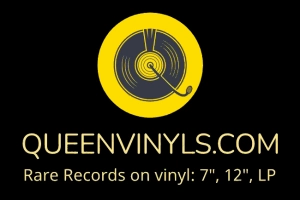




You must be logged in to post a comment.